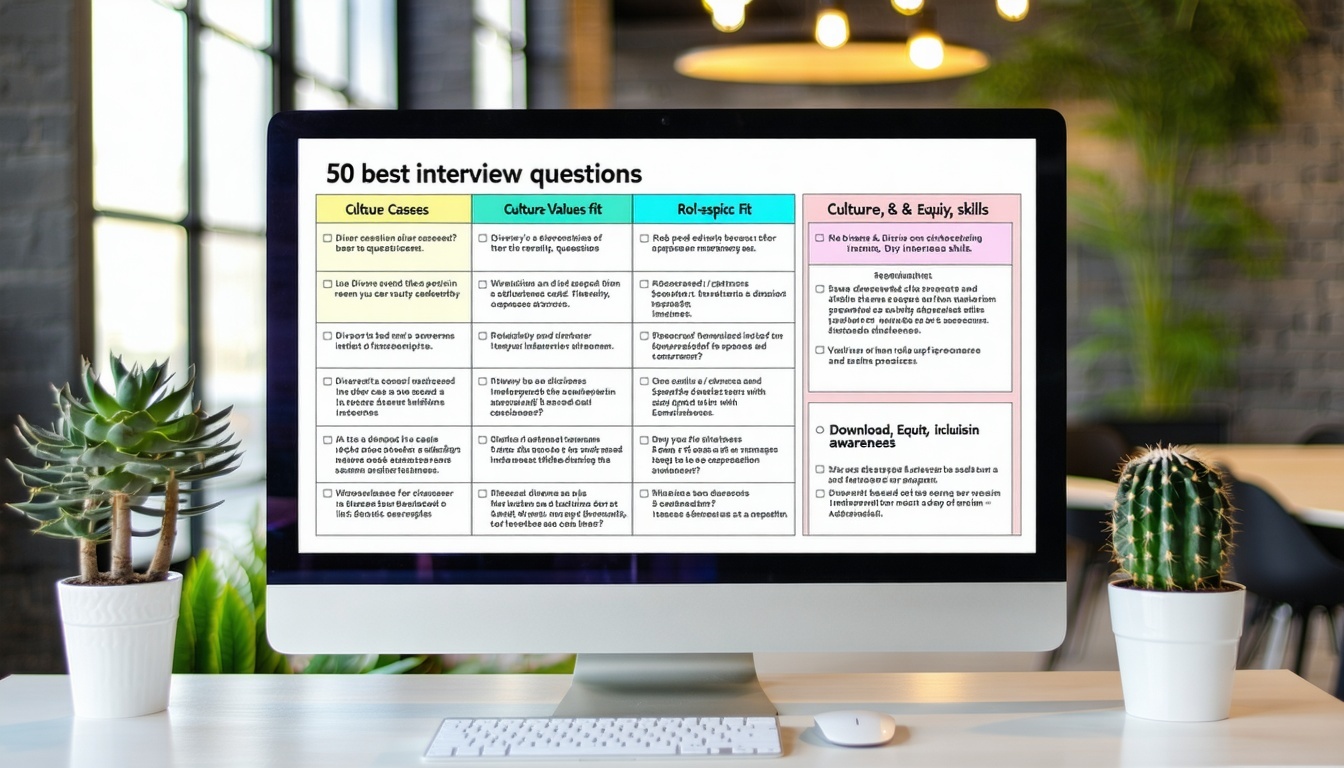
The 50 Best Interview Questions to Ask Candidates (Organized by Use Case)

Bookmark this guide — crafted with depth practicality — to keep your interviews sharp, structured, and bias‑aware. Below you’ll find 50 rigorously selected questions, grouped into 10 recruiter‑friendly use cases, complete with intent, interpretation tips, follow‑ups, and red‑flag signals. We have refined these questions over the years to achieve perfection.
Table of Contents
-
Culture & Values Fit
-
Role‑Specific Skills & Experience
-
Problem‑Solving & Critical Thinking
-
Motivation, Goals & Career Trajectory
-
Remote Work & Self‑Management
-
Sales & Revenue‑Generating Roles
-
Leadership & People Management
-
Adaptability & Continuous Learning
-
Diversity, Equity & Inclusion Awareness
-
Closing & Candidate Experience
-
People‑Also‑Ask: Termination Letters FAQ
-
Downloadable Cheatsheet
Quick‑Reference Matrix
| Use Case | Interview Goal | # of Core Questions | Signals You’re Hunting For |
|---|---|---|---|
| Culture & Values Fit | Alignment with company mission and work style | 6 | Shared principles, collaboration style, ethical standards |
| Role‑Specific Skills | Verify hands‑on capability & depth | 6 | Demonstrated expertise, impact metrics |
| Problem‑Solving | Approach to unfamiliar challenges | 6 | Reasoning clarity, structured thinking |
| Motivation & Goals | Gauge intrinsic drivers | 5 | Growth mindset, realistic ambitions |
| Remote Work | Self‑discipline, async communication | 5 | Proactivity, tooling comfort |
| Sales | Customer empathy, quota mindset | 5 | Pipeline thinking, objection handling |
| Leadership | People development & decision‑making | 6 | Coaching ability, conflict navigation |
| Adaptability | Resilience in changing contexts | 4 | Learning speed, experimentation |
| DEI Awareness | Inclusive behavior & perspective | 3 | Allyship, bias recognition |
| Closing & Experience | Candidate expectations & employer brand | 4 | Offer alignment, feedback quality |
Total questions: 50
1. Culture & Values Fit

-
Tell me about a time you had to choose between meeting a deadline and maintaining quality—what did you decide and why?
Intent: Surfaces integrity vs. delivery pressure.
Interpretation: Look for a principled trade‑off process rather than a binary choice. Did they communicate proactively? A mature answer mentions stakeholder alignment. -
What kind of work environment brings out your best performance?
Intent: Checks alignment with your team’s collaboration style.
Interpretation: Match descriptors (e.g., "fast‑paced but supportive") to your reality. Vague answers may indicate low self‑awareness. -
Describe a company value you personally disagree with and how you handled it.
Intent: Tests honesty and friction navigation.
Interpretation: Healthy dissent paired with constructive action is a green flag. -
How do you prefer to receive feedback? Give an example.
Intent: Reveals growth orientation.
Interpretation: Look for structured mechanisms (weekly 1‑on‑1s, written notes) vs. generic "I’m open to any feedback." -
What does “ownership” mean to you in a team setting?
Intent: Defines accountability scope.
Interpretation: Strong answers include proactive risk‑flagging and celebrating team wins, not just personal milestones. -
When did you last deliberately help a teammate succeed even when it didn’t benefit you directly?
Intent: Screens for collaboration over competition.
Interpretation: Listen for situational specifics and measurable impact.
2. Role‑Specific Skills & Experience
-
Walk me through a project where you used [core skill] end‑to‑end—what were the measurable outcomes?
Intent: Validates depth beyond buzzwords.
Interpretation: Numeric impact (KPIs, revenue, cycle time) proves mastery. -
Which part of the [core tool/stack] do you find most limiting, and how have you worked around it?
Intent: Advanced knowledge and creativity.
Interpretation: Practical hacks ▶ expert. Complaints without solutions ▶ novice. -
Teach me something about [domain] in 3 minutes.
Intent: Communication clarity & true understanding.
Interpretation: Simplicity and analogies show depth. -
How do you stay current in your field?
Intent: Signals continuous learning habit.
Interpretation: Look for curated communities, experiments, not just “I read blogs.” -
Describe a time you had to unlearn a best practice because evidence showed a better way.
Intent: Intellectual flexibility.
Interpretation: Metrics‑driven pivot ▶ growth mindset. -
What is the most under‑rated metric in your discipline and why?
Intent: Strategic thinking.
Interpretation: Novel yet relevant metric reveals domain sophistication.
3. Problem‑Solving & Critical Thinking
.png?width=750&height=520&name=top-missing-technical-and-soft-skills%20(1).png)
-
Tell me about the hardest problem you couldn’t solve—how did you handle the failure?
Intent: Resilience & reflection.
Interpretation: Owning outcomes and next‑step learning is key. -
How would you estimate the market size for electric scooters in Warsaw?
Intent: Structured estimation.
Interpretation: Expect top‑down logic: population ▶ TAM assumptions ▶ sanity check. -
Walk me through your first 90‑day plan for this role.
Intent: Strategic foresight.
Interpretation: Specific milestones > vague “learn the ropes.” -
Describe a decision you reversed—what data changed your mind?
Intent: Data‑driven humility.
Interpretation: Willingness to pivot quickly upon new evidence. -
If you had half the budget for your last project, what would you cut or reinvent?
Intent: Resource prioritization.
Interpretation: Insight into value vs. cost. -
Which assumptions in our business model worry you the most?
Intent: Lateral insight & due diligence.
Interpretation: Outside‑in perspective is a plus; shallow flattery is a minus.
4. Motivation, Goals & Career Trajectory
.png?width=900&height=508&name=work%20harder%20stats%20(1).png)
-
What professional achievement are you most proud of, and why does it matter to you now?
Intent: Core drivers.
Interpretation: Intrinsic story > trophy‑collecting. -
Where do you want to be in three years, and how does this role accelerate that path?
Intent: Alignment check.
Interpretation: Seek overlap between their trajectory and your roadmap. -
Describe the best manager you’ve had—what made them great?
Intent: Reveals coaching compatibility.
Interpretation: Values in a leader mirror what they need. -
What type of work drains you, and how do you mitigate that?
Intent: Self‑awareness & coping mechanisms.
Interpretation: Honest, actionable strategies show maturity. -
If money were no object, what would you work on tomorrow?
Intent: Purpose discovery.
Interpretation: Passion alignment opportunities.
5. Remote Work & Self‑Management
-
Walk me through your daily routine when working remotely.
Intent: Discipline & structure.
Interpretation: Time‑boxing and async rituals are good signs. -
How do you keep stakeholders informed without over‑scheduling meetings?
Intent: Async communication.
Interpretation: Usage of Loom, Notion dashboards, concise updates. -
Tell me about a miscommunication that happened remotely—how did you resolve it?
Intent: Conflict resolution in digital settings.
Interpretation: Empathy + channel switch shows maturity. -
Which remote‑work tool has most improved your productivity and why?
Intent: Tool literacy.
Interpretation: Insight into personal workflow optimization. -
What boundaries do you set to avoid burnout when home and work blur?
Intent: Self‑care & sustainability.
Interpretation: Clear rituals and physical cues (e.g., dedicated office) suggest healthy practices.
6. Sales & Revenue‑Generating Roles
-
Tell me the story of the toughest deal you ever closed—what made it succeed?
Intent: End‑to‑end sales process mastery.
Interpretation: Listen for discovery, ROI articulation, stakeholder mapping. -
How do you prioritize your pipeline on the first workday of each month?
Intent: Time management & forecasting.
Interpretation: A/B tiering, next steps defined. -
Give me an example of turning a ‘no’ into a ‘yes’.
Intent: Objection handling.
Interpretation: Empathy + reframing > hard‑sell tactics. -
Which metric beyond quota do you obsess over and why?
Intent: Leading indicators.
Interpretation: Pipeline velocity or conversion % reveals sophistication. -
Role‑play: You’re calling a prospect who just installed our trial but hasn’t used it—go.
Intent: Live skills test.
Interpretation: Problem diagnosis before pitching is key.
7. Leadership & People Management
-
Describe a time you coached a low performer into a top performer.
Intent: Development mindset.
Interpretation: Specific frameworks (GROW, OKRs) indicate methodology. -
How do you balance transparency with confidentiality? Provide an example.
Intent: Judgment and trust.
Interpretation: Ethical considerations. -
Tell me about the last time you changed your leadership style based on team feedback.
Intent: Adaptable leadership.
Interpretation: Concrete adjustments. -
How do you measure your team’s health beyond deliverables?
Intent: Holistic management.
Interpretation: Engagement surveys, skip‑levels, churn risk signals. -
What is your decision‑making framework when time is short and stakes are high?
Intent: Crisis leadership.
Interpretation: Synthesis ➜ options ➜ commit ➜ review. -
What would you do in your first 30 days to build trust with a new team?
Intent: Onboarding approach.
Interpretation: Listening tour, quick wins, context mapping.
8. Adaptability & Continuous Learning
-
Which skill did you learn last year that had the biggest impact on your work?
Intent: Learning velocity.
Interpretation: Clear before/after metrics. -
Tell me about a project where scope changed drastically—what did you do?
Intent: Change management.
Interpretation: Re‑prioritization communication. -
How do you detect that your current process is becoming outdated?
Intent: Meta‑thinking.
Interpretation: Regular retros, benchmarks, customer feedback loops. -
Describe an experiment you ran that failed—what happened next?
Intent: Safe failure culture.
Interpretation: Learning extraction & pivot speed.
9. Diversity, Equity & Inclusion Awareness
-
Tell me about a time you advocated for someone whose voice wasn’t being heard.
Intent: Allyship behavior.
Interpretation: Action beyond intention. -
How do you ensure your work output is accessible to diverse audiences?
Intent: Inclusive design mindset.
Interpretation: Practical adjustments (alt text, timezone diversity). -
What does an inclusive team meeting look like to you?
Intent: Psychological safety.
Interpretation: Multiple participation formats.
10. Closing & Candidate Experience
-
What questions do you have for us?
Intent: Engagement & diligence.
Interpretation: Depth > perks. -
Is there anything else we haven’t covered that you’d like to highlight?
Intent: Gives space & fairness.
Interpretation: Unique value reveals. -
What does an ideal offer look like for you beyond compensation?
Intent: Alignment on non‑monetary factors.
Interpretation: Values, flexibility, growth. -
How do you prefer to receive interview feedback if things don’t move forward?
Intent: Sets expectations; improves employer brand.
Interpretation: Professional respect signals.
Downloadable Cheatsheet & Next Steps
-
PDF Cheatsheet: All 50 questions + scoring rubric (grab it here).
-
Use AI Interviewer: EquaTalent’s Virtual AI Recruiter will conduct Behavioral interviews on your behalf. 24/7.
Final Thoughts
Hiring velocity and quality hinge on asking the right questions and decoding answers accurately. Use this guide as a living document—refine questions to your context, add role‑specific probes, and keep signals consistent. When in doubt, let data (and EquaTalent’s AI) validate your hunches.
Ready to 10× your recruiting capacity? Book a demo of EquaTalent’s Virtual AI Recruiter and watch these questions get asked—and scored—while you sleep.

.png?width=1536&height=1024&name=termination%20letter%20(1).png)